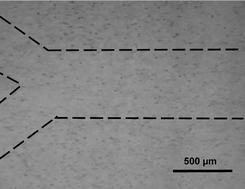Abstract
The encapsulation of mammalian cells within the bulk material of microfluidic channels may be beneficial for applications ranging from tissue engineering to cell-based diagnostic assays. In this work, we present a technique for fabricating microfluidic channels from cell-laden agarose hydrogels. Using standard soft lithographic techniques, molten agarose was molded against a SU-8 patterned silicon wafer. To generate sealed and water-tight microfluidic channels, the surface of the molded agarose was heated at 71 °C for 3 s and sealed to another surface-heated slab of agarose. Channels of different dimensions were generated and it was shown that agarose, though highly porous, is a suitable material for performing microfluidics. Cells embedded within the microfluidic molds were well distributed and media pumped through the channels allowed the exchange of nutrients and waste products. While most cells were found to be viable upon initial device fabrication, only those cells near the microfluidic channels remained viable after 3 days, demonstrating the importance of a perfused network of microchannels for delivering nutrients and oxygen to maintain cell viability in large hydrogels. Further development of this technique may lead to the generation of biomimetic synthetic vasculature for tissue engineering, diagnostics, and drug screening applications.


 Please wait while we load your content...
Please wait while we load your content...